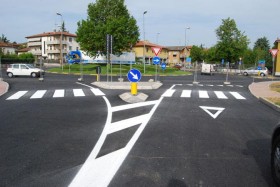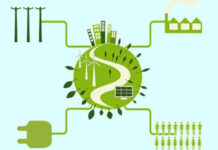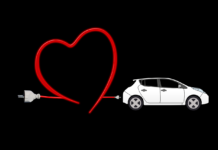
Can you give me more details about the tool?
MyCitySmarts.com is a survey for city officials to evaluate how “smart” their traffic management system is. Traffic signal ‘smarts’ are judged on four factors, traffic signal master plan, technology, performance measures and data sharing. Each factor is important to consider when looking at adopting an Intelligent Transportation Systems (ITS).
By answering a handful of questions, they can see whether they are excelling, lagging or somewhere in between, and get recommended next steps to improve the city’s traffic signal ‘smarts’.
Why is important improve the position of traffic signals? There are economical, environmental and security benefits?
To clarify, implementing a smart traffic plan isn’t about where the traffic signals are located. It’s about establishing connectivity through intelligent technology to get data from traffic signals into the hands of people who can use it to improve service for residents. Using traffic lights as connection points for a city’s network makes sense because they are distributed throughout the city.
Data from signalized intersections allows informed decisions to be made about traffic signal timing and management. Signal optimization is one of the most effective ways to improve traffic flow, which has a number of benefits:
– reducing motorist frustration caused by excessive delays or stops;
– improve safety-the number of severe collisions on city streets can be reduced by producing smoother traffic flow and fewer stops;
– reduce fuel consumption and emissions;
– the diversion of traffic off a freeway or interstate due to an incident (an accident or event) associated with a computerized signal system can be accommodated;
– emergency vehicles, buses and commercial vehicles can save time with signal pre-emption;
– the need for costly reconstruction can be postponed or eliminated by providing improved flow using existing resources in a more cost efficient manner;
– changes in traffic flow for different times of day or days of the week can be accommodated;
– real-time data from traffic signals can help adjust timing in response to ever changing city demographics, such as population fluctuations, special events, or the addition of new developments, homes and stores.
Have you some results about the more frequent obstacles for cities to improve traffic quality?
They really vary depending where the city is in the process. However, the foundation of improving traffic quality is based around access and secure communications of data from traffic signals to the Traffic Management Centre (TMC). Miovision has been conducting an annual peer survey on the state of traffic signals across North America for several years. Most recently, traffic signal connectivity was the #1 five-year goal of respondents – a critical foundation for Intelligent Transportation Systems and ‘smart’ traffic signals. While 48% of intersections were reported to be connected, respondents had a desired connectivity level of 81%.
Cities often state that obstacles to connectivity include lack of technology compatibility, cost and disruption. Traffic signal technology hasn’t changed much in ~30 years, so the legacy infrastructure controlling signals is often not compatible with today’s digital equipment. In order to access data in signalized traffic intersections many solutions require existing equipment to be ripped out and replaced, even if it’s still in good working order.
Other connectivity options include fiber optic cable – an excellent choice but for the enormous expense and disruption for local business and residents. The US Department of Transportation Intelligent Transportation Systems Joint Program Office cost database for Unit Cost Entries for Fiber Optic Cable Installation averages over $37,500 cost per linear foot for fiber optic cable and installation. Further, installation requires the road to be torn up, environmental analysis to be done, and significant disruption for local businesses and residents. And, if the fiber happens to be damaged or cut it can take months to get back on line.
Connectivity is just the start of ‘smart’ traffic management. Once signals are connected and traffic signal data is easily attained, cities need a Central Management System (CMS), a solution to monitor the state of the traffic network and offer data-drive insights into traffic signal optimization. This software can be very costly, up to $250,000 per seat with renewal costs about every 5 years. This only gives one computer access to the system at a time, which can certainly limit the opportunity for a traffic department to optimize the system.
Further, as new software modules are developed, many transportation departments do not have access to ongoing training and education to make the most of the new tools. Traffic engineers are faced with a myriad of new data and information, but this is only useful if it can be actioned appropriately. Lastly, improvements in the traffic system can be enhanced if data is shared with other departments, and the public. By putting this data into the hands of many, new innovations are likely to emerge. Cities face obstacles with nebulous open data policies, or lack of resources to manage data security and privacy.
These factors conspire to make traffic signal improvements daunting.
Which are the better technologies that can ameliorate the traffic in the cities?
Miovision’s Spectrum is an intelligent transportation system (ITS) solution hub that integrates with a city’s traffic signal infrastructure, providing remote monitoring and data insights required to better understand and manage the traffic signal network. Spectrum hardware is installed into the existing traffic cabinet, without the need to replace any legacy infrastructure. The system acquires and securely communicated data from all cabinet devices. Miovision Signals is a web-portal available for remote access to real-time information about traffic conditions and alerts. Spectrum provides traffic agencies with the right information at the right time in order to keep traffic moving and solve problems before they escalate.
How much importance have traffic signals in smart traffic and in smart cities?
Traffic signals are the perfect foundation for a smart city. First, it’s easy and affordable to integrate smart technology such as Miovision’s Spectrum, which plugs directly into the traffic cabinet and connects signals to the Internet. Plus, you can attach video cameras or sensors and collect data about traffic patterns through the intersection. Second, they’re everywhere. In North America alone there are about 340,000 traffic signals, giving cities a lot of data collection points. Third, intersections collect a lot of data, including vehicle, bike and pedestrian counts, traffic speed, intersection approach volume, congestion, accident surveillance, public transit monitoring and traffic signal timing. Fourth, there’s an opportunity for immediate impact just with improving signal timing and being able to monitor and manage signals remotely. And lastly, smarter traffic signals don’t just optimize traffic. Connectivity enables integration with other data points. In the future, smart signals and sensors will deliver data like weather, crash reports and road conditions. Think of your city as a network of arteries providing check-in points to help you navigate the city most efficiently. Once ‘smart’ traffic signals have been deployed, data integration points are only limited by the imagination.
How much are the expected savings for administrations thanks to the tool?
The MyCitySmarts tool is designed to help cities on their path to improve traffic flow.
MyCitySmarts.com provides a customized infographic with an overall smart traffic signal score and an in-depth breakdown in four key areas: building an Intelligent Transportation System (ITS) master plan; adopting the right technologies to meet goals; evaluating traffic signal system performance; and openly sharing traffic data with stakeholders.
A lot of cities are starting to investigate smart traffic technology, but many simply don’t know where to start. It can be a daunting task. The MyCitySmarts survey will help cities identify the challenges to building such a system, and provide information about how to overcome them. By comparing responses from different stakeholders within the city, this tool can help ensure that teams are on the same page when it comes to setting priorities and implementing changes.
While the tool itself will not provide direct cost savings, the results will prompt important questions within the city, can engage all the required stakeholders and help identify a number of available solutions for cities to investigate in order to improve the transportation experience for citizens.
Facts on Signal-Related Congestion Delays & Costs / Savings:
-Traffic signals contribute an estimated 5 to 10 percent of all traffic delay or 295 million vehicle-hours of delay on major roadways alone. *Source: Congestion Reduction Toolbox. U.S. Department of Transportation Federal Highway Administration. Accessible via www.fhwa.dot.gov/congestion/toolbox
-Further, the 2011 Urban Mobility Report notes that in its reporting areas 61 percent of the street miles in the cities had some level of traffic signal coordination that reduced delay by 21.7 million person hours. *Source: 2011 Urban Mobility Report. Methodology-Benefits of Operational Treatments. Texas Transportation Institute, 2011. Accessible via http://mobility.tamu.edu/ files/2011/09/operational-treatments.pdf
-The U.S. Department of Transportation Intelligent Transportation Systems Joint Program Office maintains a database that documents traffic signal management and operations studies conducted by various agencies demonstrating benefit-cost ratios exceeding 40:1.3 *Source: ITS Benefits, Costs and Lessons Learned Database. U.S. Department of Transportation (U.S. DOT) Intelligent Transportation Systems Joint Program Office. Accessible via www.benefitcost.its.dot.gov
-There are about 300,000 traffic signals in the United States alone and over 75% of them could be improved by updating equipment or adjusting the timing. Traffic signal retiming is one of the most cost-effective ways to improve traffic movement and make our streets safer. Comprehensive signal retiming programs have documented benefits of 7-13% reduction in overall travel time, 15-37% reduction in delay and a 6-9% fuel savings. *Source: ITE Website via http://www.ite.org/signal/index.asp
Per ricevere quotidianamente i nostri aggiornamenti su energia e transizione ecologica, basta iscriversi alla nostra newsletter gratuita
e riproduzione totale o parziale in qualunque formato degli articoli presenti sul sito.



















